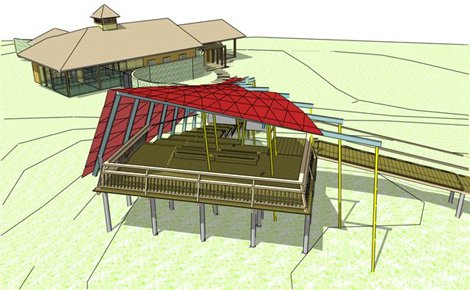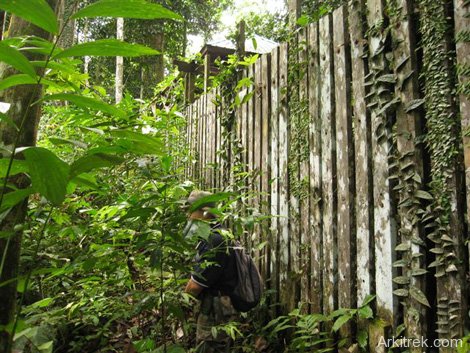Bornean Sun Bear Conservation Centre
Above is a concept design image for a sun bear conservation centre proposed adjacent to the Sepilok Orang Utan Sanctuary at Sandakan in Sabah.
Juvenile sun bears are undeniably cute and the adults are very handsome. Fully grown they would be a little above my knee in height, although rearing on hind legs they can be much more intimidating. Regrettably I have only seen them behind bars. The closest I have come to a wild sun bear was when I heard one raiding the kitchen during the night at Agathis Camp in Maliau Basin.
Sun bears are adaptable animals but unfortunately their habit of diversifying into convenience food often brings them into conflict with humans. Humans are also known to trap bears without provocation on the spurious grounds that bear body parts have medicinal properties. Also the fact that young bears are cute makes them popular in the illegal pet trade.
The sun bear’s main handicap to their conservation however, is their ecological position as an apex predator. The effect of this is that they live at very low densities. In the rainforest of Sabah, my friend Siew Te Wong estimates that they occur at the rate of approximately one bear to ten square kilometers. You do not have to chop down a lot of rainforest to make a big relative dent on the sun bear population.
Wong estimates that there may be 10,000 sun bears in their home range across Southeast Asia. To put this in perspective the estimated orang-utan population is approximately 50,000 with 41,000 of these in Borneo. Most people are familiar with orang utans, but the sun bear remains the least known of the eight species of bear and certainly attracts much less attention than their anthropomorphic red hairy neighbours.
The Borneo Sun Bear Conservation Centre (BSBCC) will be the first of it’s kind in Malaysia and is being set up in partnership with the Sabah State Wildlife and State Forestry Departments. It’s long term goal is to raise the profile and support for sun bear conservation. The first and most pressing objective however is to provide better welfare for sun bears currently being held in captivity in Sabah.
There are 9 bears in Sepilok at the moment and several more distributed across Sabah. Most of these animals have either been confiscated by or been deposited with the Wildlife Department. They are held in small cages with no access to outside spaces.
The brief of BSBCC is to provide individual night time denning for 36 bears in two phases. There will be additional cages for quarantine, treatment and birthing. A vital facility to the well being of the bears is to provide every animal with controlled access to primary forest during daytime. The total area of forest pens will be about 2 hectares and bears will be prevented from escaping using fences and hot-wires. The Forestry Department has approved a part of the Sepilok Forest Reserve to be used for this purpose and the Wildlife Department has given the go ahead to adapt an enclosure formerly designed to contain Sumatran Rhinoceros.
The final component of the brief is to provide staff facilities plus a shop and visitor centre. Tired of stuffy ‘nature interpretation galleries’, the Arkitrek concept is interpretive information presented as a walk from the built environment into the forest. The walk is designed to be accessible to everyone and culminates in an observation gallery which is part seminar space, part interpretive display and part pavilion in the forest from where sun bears can be observed in their natural environment.
Did you like the use of the word ‘pavilion’ just there? Architects love that word [ed]
Related Posts
%RELATEDPOSTS%




